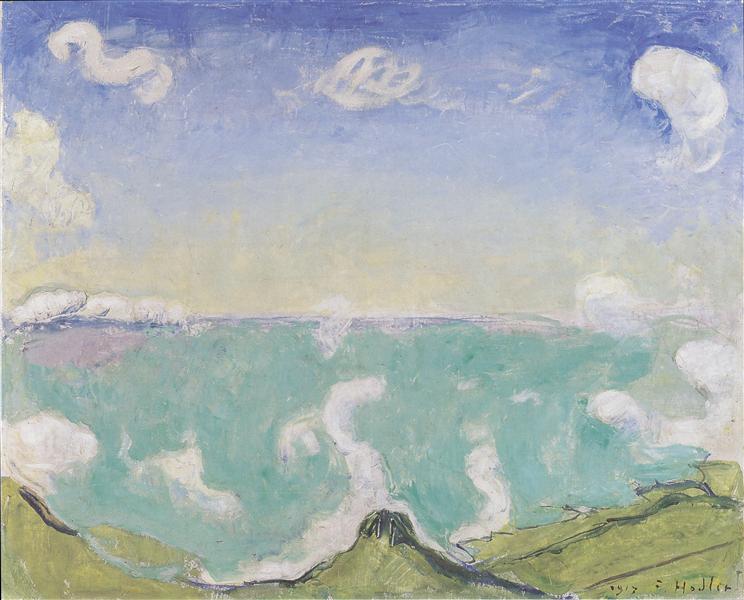Description
"Caux landscape with growing clouds" of 1917 is a painting that sublime the innate ability of Ferdinand Hodler to unite the majesty of nature with a deep emotional expression. Hodler, a renowned Swiss painter of the nineteenth to the twentieth century transition, known for its landscapes, portraits and symbolic scenes, shows in this work an consummated dominance of composition and color.
This particular painting is a testimony of Hodler's mature style, characterized by the simplification of forms and rhythmic repetition, what he called "parallelism." In "Caux landscape with growing clouds", Hodler presents a vast landscape of wavy hills and a sky in transformation, with clouds that seem to grow and move almost palpable. The work lacks human figures, focusing exclusively on the grandiosity of the natural environment, which is a deliberate choice to evoke a sensation of timelessness and universality.
The use of color in this work is particularly remarkable. The green and brown tones of the hills, together with the ethereal and gray blue of the clouds, create a contrast that is both serene and dynamic. Hodler uses a vibrant but contained chromatic language, avoiding the excesses of color that could divert the attention of the underlying harmony of the scene. Through their brushstrokes, you can almost feel the weight and texture of the clouds, which seem to manifest with their own life about the quiet landscape of Caux.
The composition of the painting follows a horizontal scheme that guides the viewer's gaze through the vast space represented. The horizontal lines of the hills and the horizon provide stability, while the soft and fluid forms of the clouds add an element of movement and change. This balance between terrestrial serenity and celestial dynamism is a distinctive characteristic of Hodler's artistic approach.
It is not only technical precision that highlights in this work, but also Hodler's ability to imbue his landscapes of a sense of spirituality and contemplation. In "Caux landscape with growing clouds", one can perceive a reflection on the relationship between man and nature, time and life itself, although there is no human figure present. The absence of human figures makes nature the undisputed protagonist, reflecting a kind of universal and immutable peace.
To better understand this painting, it is useful to place it in the context of other Hodler works. Their landscapes often exudate a similar meditative quality, as can be seen in works such as "El Lago de Thun" (1905) and "The mountains of Eiger, Mönch and Jungfrau" (1908). In these paintings, As in "Caux landscape with growing clouds", Hodler decomposes nature in its essential elements, eliminating any unnecessary distraction and allowing the inherent beauty of the earth and the sky to manifest in a pure and evocative way.
In summary, "Caux landscape with growing clouds" is a work that encapsulates the essence of Ferdinand Hodler's artistic approach. Through its balanced composition, masterful use of color and the absence of human figures, painting offers deep meditation on nature and our connection with it. This work is not only a visual representation, but also an invitation to contemplate and reflect on the grandiosity and serenity of our natural environment.
KUADROS ©, a famous paint on your wall.
Hand-made oil painting reproductions, with the quality of professional artists and the distinctive seal of KUADROS ©.
Art reproduction service with satisfaction guarantee. If you are not completely satisfied with the replica of your painting, we refund your money 100%.

